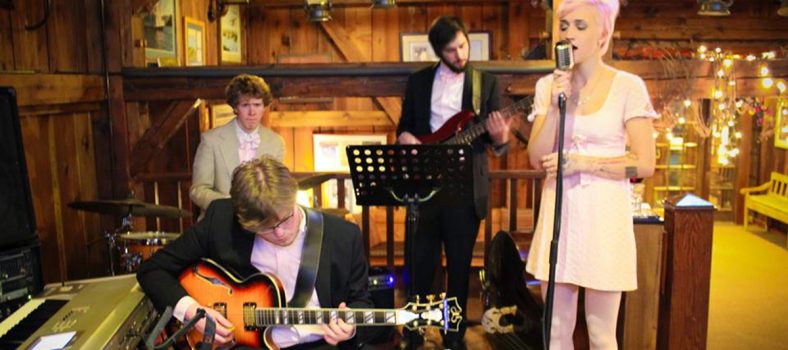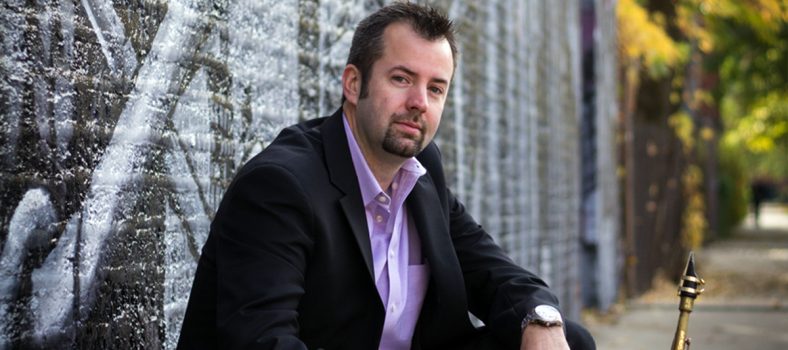When Robert Hurst was growing up in Detroit, so many kinds of great music tugged at him, he could easily have gone in a different direction than jazz. Motown influences abounded: Marvin Gaye lived in his neighborhood, his father was boyhood friends with two of the Temptations, and the music of legendary bassist James Jamerson, a hero of young Robert’s, was in virtual residence in the Hurst household. Meanwhile, George Clinton’s Parliament and Funkadelic were shaking the foundations of R&B and funk; rockers Ted Nugent, Bob Seger, and Iggy Pop and the Stooges were raising a ruckus; and the first family of gospel, the Franklins, was raising roofs.
Luckily, it was Detroit’s vaunted jazz tradition—and its great jazz bassists, including Paul Chambers, Ron Carter, and Doug Watkins—that won over Hurst and set in motion a remarkable career that has included close associations with Wynton and Branford Marsalis, Charles Lloyd, Tony Williams, Diana Krall, Ravi Coltrane, and Christ Botti. It was Detroit trumpet legend Marcus Belgrave who closed the deal for Hurst by taking him under his wing at a high school music clinic and subsequently hiring him at age 15 to play in his band.
“Without Marcus Belgrave, I would not be where I am today,” Hurst recalls. “I’ll never forget that time he came to my high school. I was in tenth grade. I asked if I could play a tune with him. He said yes and we really hit it off. When it was my turn to solo, he accompanied me on trumpet, guiding me through the piece. That’s not something most musicians of his stature would have done. Most musicians would have walked off stage to talk to a girl or something and waited until I was finished to come back.”
All these years later, Belgrave, an alumnus of Ray Charles’s great 1950s band, is a fixture on Hurst’s recordings. On the latest, BoB: A Palindrome, he joins a stellar lineup including Branford Marsalis, Robert Glasper, Bennie Maupin (another Detroit great), Jeff “Tain” Watts, and Adam Rudolph. Now, it’s Hurst generously supporting his fellow players with his deep harmonic feel, counter-melodic ingenuity, and surpassing clarity on bass, and reaching out to them with his wide-ranging compositions— conceived, he said, in the Ellington tradition, “with the specific tones and particular talents of the musicians in mind.” The airy harmonies of Branford’s soprano saxophone and Maupin’s flute are especially well utilized.
Drawing on originals written as far back as 1985, BoB: A Palindrome was recorded in October of 2001, when the shocks of 9/11 were still reverberating. In drawing warm inspiration from people who have played important roles in Hurst’s life, the sessions proved to be an exercise in spiritual healing. The jaunty and elegant “3 for Lawrence,” which begs for a big band treatment, pays tribute to Lawrence Williams, a drummer and composer from Detroit who set an important example for Hurst before his untimely death. The patiently unfolding, powerfully climactic “Big Queen” and sweetly reflective “Little Queen” were written for Hurst’s wife (and manger) Jill and daughter Jillian. The lustrous “Tigers on Venus” commemorates a day on which Tiger Woods and Venus Williams both triumphed, a doubly proud moment for African Americans.
Then there’s “Middle Passage Suite,” a lyrical, three-part meditation on black history inspired in part by Charles Johnson’s prize-winning novel, Middle Passage. And the Headhunter-like “Jamming (Ichabad),” a fusion-y workout that as literary sleuths can deduce from the parenthetical reference, has no head.
The fifth release on Hurst’s own Bebob label, BoB: A Palindrome immediately follows a pair of simultaneously released, critically praised 2011 albums: Unrehurst, Volume 2, an electrifying live piano trio date recorded in 2007 featuring Robert Glasper and Chris Dave (Unrehurst, Volume 1, featuring Glasper and Damian Reed, came out in 2004), and Bob Ya Head, a politically tinged, radio-friendly studio work that delves into Afro-pop and electronica. It features percussionist Darryl Munyungo (a percussionist known for his work with Miles Davis, Herbie Hancock, and Stevie Wonder), children’s voices, a sampled speech by Malcolm X, and, of course, the horn of Marcus Belgrave, who Hurst said “is always in the moment and constantly ready to lead the music in a new direction.”
Few are aware that it was a Philadelphian, Percy Heath, who inspired Hurst to take up the bass. When he was seven, his father (a trailblazing African-American businessman in the telephone industry) and mother took him to see the Modern Jazz Quartet at Baker’s Keyboard Lounge. Between sets, Hurst got to chat with Heath about his antique Ruggeri bass. “He was a very distinguished and regal individual,” recalls Hurst.
Another fateful night came when Hurst was 16. In Pittsburgh to perform with Belgrave in a band including Detroit-bred pianist Geri Allen, Hurst struck up a friendship with Iron City native Jeff “Tain” Watts, Wynton Marsalis’s drummer at the time. They played with Watts until four in the morning at an after-hours club. On the strength of Watts’s recommendation, Marsalis invited Hurst to read through some music with his band, sending him a plane ticket to join them in New York. Hurst ultimately took him up on his offer, but not until several years later, after completing his education at the University of Indiana.
In 1985, the year he made his recording debut on Out of the Blue, a Blue Note Records project featuring a group of young lions including Kenny Garrett and Ralph Peterson, Hurst began touring with Wynton Marsalis. He stayed with the band (which initially included brother Branford and pianist Marcus Roberts) for three years, appearing on such classics as Live from Blues Alley and J Mood.
This was a time when Marsalis was using his stardom to rally acoustic jazz in a battle for attention with fusion and funk. “That was when I started to take myself seriously as a jazz musician and began feeling a real sense of pride in being one,” said Hurst, who further credits the New Orleans players he has worked with, including patriarch Ellis Marsalis, Terence Blanchard, Donald Harrison, and Harry Connick Jr., with “helping me get my historical music chops together.”
Hurst valued Wynton’s work ethic: “When we’d take a couple of days off, Wynton would come in with two or three new tunes he’d just written while everyone else was relaxing.” In the close-knit band, Hurst became tight with Branford, with whom he shared an interest in things not jazz, including hip-hop. He joined the saxophonist’s band after a stint with the great Tony Williams. In 1992, when Branford accepted newly installed Tonight Show host Jay Leno’s invitation to become leader of the program’s band, Hurst relocated to Los Angeles to join him. After Branford left the show in 1995 and was replaced by guitarist Kevin Eubanks, Hurst remained in the band for another six years.
His L.A. experience was a valuable one. He performed with and wrote arrangements for every conceivable kind of artist, from Willie Nelson and Boys II Men to Barbra Streisand and the Kinks. And though many people think Los Angeles is a jazz desert, he continued to play club dates with brilliant visiting artists including Greg Osby, Pharoah Sanders, and Geri Allen. At a local event sponsored by the Thelonious Monk Institute, he received a call to substitute for John Patitucci in Wayne Shorter’s quartet—“one of the highlights of my life.” And then, he began scoring major motion pictures and films including The Wood and Brown Sugar. His improvised and composed performance contributions can be heard on a list of blockbusters including Oceans 11, 12, and 13, Good Night and Good Luck, and Men in Black, fueling his efforts to become known as more than a bass player.
Hurst’s first album as a leader, Robert Hurst Presents Robert Hurst (1993), featuring Branford, Belgrave, and Tonight Show pianist Kenny Kirkland, garnered a four-star review from DownBeat, which deemed it “an ambitious debut on which the melodic, rhythmic and harmonic appear, disappear, and reappear, and are tossed adeptly from one band member to another.” Its sequel, the trio session One for Namesake, teamed him with superhuman drummer Elvin Jones—yet another Detroit legend. “I had played with Elvin on Wynton’s ‘Thick in the South,’ but it was still pretty amazing,” said Hurst. “He had a reputation for being difficult to work with, but he was very cool with me. I tried to get Hank Jones on the project to make it an all-Detroit affair, but was unable to make that happen.”
In 2004, Hurst became an Associate Professor of Music, now tenured, at the University of Michigan. It was a great development, but a complicating one for his career. He had hoped to release BoB: A Palindrome by then, but in the days following 9/11, it was difficult to find time to put all of its pieces together and discussions to do “a label thing” didn’t pan out. Between flying back and forth between Los Angeles and Michigan and recording and touring with Diana Krall and Chris Botti, he also needed more time to complete Bob Ya Head, which he began working on during Barack Obama’s first presidential campaign (“Obama’s Victory Dance” celebrates the happy outcome).
Fortunately, the difficulties of completing and releasing these projects now reside safely in the past. And, if Hurst’s cup of good fortune wasn’t full enough with those recordings, it runneth over with his contribution to a bestselling 2012 album by a certain fellow bassist from England. What was it like encountering Sir Paul McCartney when he played with Krall on the former Beatle’s first standards album, Kisses on the Bottom? “That was very, very cool,” says Hurst. “He was really into it. We talked a lot about different musicians, especially the bass players we liked.”
We can safely assume that Sir Paul will be including Robert Hurst III in all future such discussions. •





